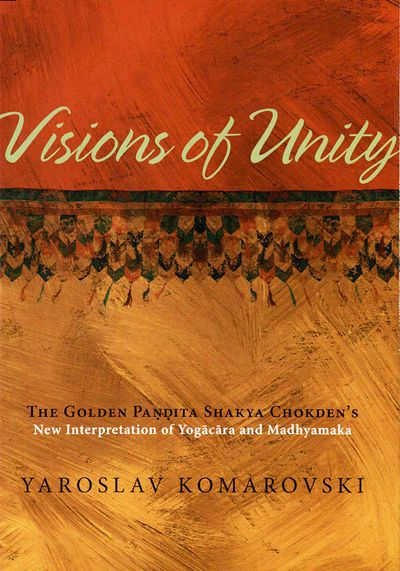- List of Tables ix
- Acknowledgments xi
- Introduction 1
- 1. Introducing the Visions of Unity 6
- 2. Introducing the Chapters 11
- Chapter One: Life and Works of the Golden Paṇḍita 17
- 1. Political and Religious Landscape of Fifteenth-Century Tibet 17
- 2. Life of the Golden Paṇḍita 23
- Early Years and Education 25
- Becoming a Prolific Writer and Famous Scholar 31
- Settling in the Golden Monastery and Exploring New Horizons 35
- Becoming a Tantric Master and Crystallizing Novel Views 44
- 3. Writings of Shakya Chokden 51
- Chronological List of Shakya Chokden's Works 51
- Topical Divisions of Shakya Chokden's Works Addressed in This Book 59
- Chapter Two: The Intellectual Background of Shakya Chokden's Interpretation of Yogācāra and Madhyamaka 71
- 1. Two Tendencies in Yogācāra and Niḥsvabhāvavāda Writings 71
- 2. Basic Elements of Shakya Chokden's Approach to Mahāyāna Systems 84
- 3. Pointed Disappointments: Shakya Chokden's Personal Reflections 91
- 4. Broadening Empty Horizons: A Note on Changes in Shakya Chokden's
Views 102
- Chapter Three: Readjusting Rungs of the Ladder: Revisiting Doxographical Hierarchies 109
- 1. Key Features of Shakya Chokden's Approach to the Buddhist Tenets 109
- 2. Demarcating the Middle: On the Valid Divisions of Madhyamaka and Great Madhyamaka 116
- 3. Self-Emptiness and Other-Emptiness 122
- Self-Emptiness 124
- Other-Emptiness 127
- 4. Bidding Farewell to the Prāsaṅgika/Svātantrika Division? 136
- 5. Are There Two Types of Yogācāra Madhyamaka? 141
- 6. Are There Any Cittamātra Followers Around? 145
- 7. Expanding the Madhyamika Camp 150
- Chapter Four: Through Broken Boundaries to New Enclosures: Reconciling
Yogācāra and Madhyamaka 157
- 1. Differences between Alīkākāravāda and Satyākāravāda 157
- 2. The Heart of the Matter: Probing the Alīkākāravāda/ Niḥsvabhāvavāda Distinction 168
- 3. A New Look at the Old Origins: Distinctions of Madhyamaka Stemming
from Interpretations of the Second and Third Dharmacakras 183
- Looking at the Second and Third Dharmacakras through the Eyes of the Madhyamaka Founders 183
- Position of Alīkākāravāda 186
- Position of Niḥsvabhāvavāda 191
- Positions of Later Madhyamikas 201
- 4. Steering the Middle Way between the Two Conflicting Middle Ways:
The Art of Not Taking Sides 207
- Chapter Five: Explorations in Empty Luminosity: Shakya Chokden's Position on Primordial Mind 213
- 1. Facing the Reality of Primordial Mind 213
- Primordial Mind and the Question of Existence 213
- The Question of Withstanding Analysis 220
- Does True Existence Have to Be Negated in Order to Abandon Grasping at It? 223
- 2. Primordial Mind as an Impermanent Phenomenon 228
- 3. (Un)linking the Self-Cognizing Primordial Mind and Dualistic Consciousness 238
- 4. Does Self-Cognition Cognize Itself? 242
- 5. Primordial Mind as the Bridge between Yogācāra and Tantra 249
- Primordial Mind as the Focus of All Mahāyāna Paths 249
- Different but Concordant Approaches to Primordial Mind in Alīkākāravāda and Tantra 252
- A Powerful Ally: Using the Tantric View of Reality for Support 264
- Conclusion: The Grand Unity—Shakya Chokden's Middle Way 269
- Glossary of Buddhist Terms: English-Tibetan with Sanskrit Parallels279
- Spellings of Tibetan Names and Terms299
Yaroslav Komarovski's Visions of Unity is a thick study of Śākya Chokden, a fifteenth-century Sakya philosopher who wrote extensively on Yogācāra and Madhyamaka in an attempt to synthesize the two. He wrote at a time that a strict interpretation of Madhyamaka was in ascendence and Yogācāra was dismissed as a lesser teaching. Śākya Chokden was a passionate critic of Tsongkhapa, and stridently faulted the Geluk patriarch for spreading nihilism to his own beloved Sakya tradition. He was himself a follower of Madhyamaka, but he embraced many elements of Yogācāra; his attempt at a synthesis was to reclassify the different strands of Yogācāra and Madhyamaka so as to combine those that he liked and dispense with those he did not. Although his writings were recognized for their brilliance, his criticisms of Tsongkhapa and Sakya Paṇḍita, and his qualified acceptance of "other-emptiness" (gzhan stong) meant that he was almost entirely rejected by his peers.
Śākya Chokden was an accomplished scholar and practitioner of tantra, and his eagerness to preserve elements of Yogācāra arose from his desire to provide an intellectual basis by which to merge sūtra and tantra. Komarovski skillfully places Śākya Chokden in a long history of Yogācāra-Madhyamaka syntheses, a tradition that Śākya Chokden accused Tsongkhapa of abandoning in his radical interpretation of Candrakīrti and rejection of all positive-language doctrine.
Tibetan philosophers frequently turned to doxography to advocate their own interpretation of Buddhist doctrine. Since no teaching of the Buddha could be discarded, all had to be organized in a soteriological hierarchy; that is, the teachings that best bring a practitioner to a realization of the ultimate are better than those teachings that were offered to soothe fears or inspire action. For
Geluk thinkers who Śākya Chokden opposed, for example, the teachings of buddha-nature were not to be taken literally. In his effort to merge the positive- and negative-language teachings of
Yogācāra and
Madhyamaka, Śākya Chokden developed a unique doxography that redefined both. In dense but readable prose Komarovski explains how Śākya Chokden reclassified elements of each (the Satyākāravāda doctrine of the
Yogācāra, and the Prasaṅgika branch of the
Madhyamaka) as true
Madhyamaka; each was capable of bringing people to a realization of the ultimate, one with positive language and the other with negative.


